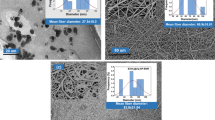Abstract
Heavy metal copper ion pollution has enormously threatened ecosystem and public health. So, materials for detecting and adsorbing copper ions (Cu2+) still remains challenging. Electrospinning nanomaterials have good application prospects in the field of water treatment because of its high specific surface area, high porosity and three-dimensional structure. Here, a visualized chitosan/polyacrylonitrile (CS/PAN) nanofiber membrane (NFM) was prepared via the amination modification of the electrospinning membrane and the do** of Cu2+ fluorescent probe to adsorb Cu2+. The effect of membrane absorbs Cu2+ in water was studied from the aspects of initial Cu2+ concentration, PH and adsorption time. It was found that when the pH value of the Cu2+ environment is 5–6, the weight gain rate of aminated nanofiber membrane is 46 %, and the adsorption time is 90 minutes, the adsorption capacity of the NFM can reach 164.3 mg/g. Then, rhodamine hydrazide derivatives were used as fluorescent Cu2+ probes, which were added to the spinning solution to prepare new NFM to achieve selective recognition of Cu2+. The membrane can be used multiple times and can achieve gradient color development of different concentrations of Cu2+, and the detection limit can reach 10−8 M.
Similar content being viewed by others
References
W. Diao, W. Ni, T. Ni, and X. Yang, Guangdong Trace Elem. Sci., doi:https://doi.org/10.16755/j.cnki.issn.1006-446x.2004.03.001 (2004).
R. McRae, P. Bagchi, S. Sumalekshmy, and C. Fahrni, Chem. Rev., 109, 4780 (2009).
J. Yang, J. Xue, and G. J. Kuatian, Agro-Environ. Sci., 18, 268 (1999).
R. A. Wuana and F. E. Okieimen, ISRN Ecol., 2011, 402647 (2011).
M. L. Thompson and R. L. Scharf, J. Environ. Qual., 23, 378 (1994).
W. W. Bedsworth and D. L. Sedlak, J. Environ. Sci. Technol., 33, 926 (1999).
F. J. Stevenson and Y. Chen, Soil Sci. Soc. Am. J., 55, 1586 (1991).
W. Kuo and G. F. Parkin, Wat. Res., 30, 915 (1996).
N. I. Chubar, V. A. Kanibolotskyy, V. V. Strelko, G. G. Gallios, V. F. Samanidou, T. O. Shaposhnikova, V. G. Milgrandt, and I. Z. Zhuravlev, Colloids Surf., A., 255, 55 (2005).
Y. Sang, Q. Gu, T. Sun, F. Li, and C. Liang, J. Hazard. Mater., 153, 860 (2008).
T. A. Kurniawan, G. Y. S. Chan, W. H. Lo, and S. Babel, Chem. Eng. J., 118, 83 (2006).
P. Hadi, M. Xu, C. Ning, C. S. K. Lin, and G. McKay, Chem. Eng. J., 260, 895 (2015).
Y. H. Zhao, K. **a, and Z. Z. Zhang, Nanomater., 9, 455 (2019).
Z. Z. Zhang, K. **a, and Z. W. Pan, Appl. Surf. Sci., 500, 143970 (2020).
Z. Z. Zhang, Z. W. Pan, and Y. F. Guo, Appl. Catal. B Environ., 261, 118212 (2020).
X. Wang, Z. Z. Zhang, and Y. H. Zhao, Nanomaterials, 8, 673 (2018).
K. **a, Y. F. Guo, and Q. J. Shao, Nanomaterials, 9, 1532 (2019).
R. Y. M. Huang, R. Pal, and G. Y. Moon, J. Membr. Sci., 160, 17 (1999).
T. Uragami, S. Kato, and T. Miyata, J. Membr. Sci., 124, 203 (1997).
J. Ge, Y. Cui, Y. Yan, and W. Jiang, J. Membr. Sci., 165, 75 (2000).
S. Babel and T. A. Kurniawan, J. Hazard. Mater., 97, 219 (2003).
A. Ghaee, M. Shariaty-Niassar, J. Barzin, and T. Matsuura, Chem. Eng. J., 165, 46 (2010).
X. Xu, W. Hu, Q. Ke, H. Liu, J. Li, and Y. Zhao, Text. Res. J., 90, 1094 (2020).
S. Ramakrishna, K. Fujihara, W. E. Teo, T. Yong, Z. Ma, and R. Ramaseshan, Mater. Today, 9, 40 (2006).
P. Kampalanonwat and P. Supaphol, Energy Procedia., 56, 142 (2014).
A. H. Chen, S. C. Liu, C. Y. Chen, and C. Y. Chen, J. Hazard. Mater., 154, 184 (2008).
J. Dong, J. Wei, H. Li, and L. Wei, J. Tian** Polytech. Univ., 26, 8 (2007).
P. Kampalanonwat and P. Supaphol, ACS Appl. Mater. Interfaces, 2, 3619 (2010).
M. R. Huang, H. J. Lu, and X. G. Li, J. Mater. Chem., 22, 17685 (2012).
H. Yan, J. Dai, Z. Yang, H. Yang, and R. Cheng, Chem. Eng. J., 174, 586 (2011).
C. Shen, Y. Wen, X. Kang, and W. Liu, Chem. Eng. J., 166, 474 (2011).
Acknowldgments
This research was partly supported by the ChangJiang Youth Scholars Program of China and grants (51773037 and 5197030342) from the National Natural Science Foundation of China to Prof. **aohong Qin as well as the “Innovation Program of Shanghai Municipal Education Commission”, “Fundamental Research Funds for the Central Universities” and “DHU Distinguished Young Professor Program” to her. This work has also been supported by grant 51803023 from the National Natural Science Foundation of China to Dr. Hongnan Zhang and the Shanghai Sailing Program (18YF1400400), the Project funded by China Postdoctoral Science Foundation (2018M640317) and the Fundamental Research Funds for the Central Universities (2232018A3-11).
Author information
Authors and Affiliations
Corresponding author
Rights and permissions
About this article
Cite this article
Zhang, H., Yao, C. & Qin, X. A Visually Observable Copper Ion Adsorption Membrane by Electrospinning Combined with Copper Ion Probe. Fibers Polym 22, 1844–1852 (2021). https://doi.org/10.1007/s12221-021-0737-z
Received:
Revised:
Accepted:
Published:
Issue Date:
DOI: https://doi.org/10.1007/s12221-021-0737-z




